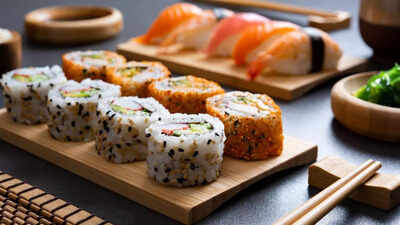ARTICLE AD BOX

Whether it’s buttery slices of sashimi, perfectly seasoned nigiri, or vibrant sushi rolls bursting with textures, sushi is more than just food, it’s an art form with centuries of tradition.
To fully appreciate it, it’s necessary to understand the proper way to eat each type, not just for flavor, but out of respect for the craftsmanship behind every bite. From how you handle your chopsticks to the way you dip in soy sauce (yes, there's a wrong way), these details matter more than you might think.But before we get into the nitty gritties, let us understand what sushi is and what are the different types.At its core, sushi refers to vinegared rice paired with other ingredients like raw fish, vegetables, or egg.
The roots of sushi go deep — born in Japan as a way to preserve fish, it has evolved into a refined culinary tradition with specific ways to prepare, present, and enjoy each bite.
Sashimi
Thinly sliced raw (or occasionally cooked) fish or seafood, served without rice. It’s all about freshness and purity, typically enjoyed with soy sauce, wasabi, or ponzu.Examples: Sake (salmon), Maguro (tuna), Uni (sea urchin), Unagi (grilled eel), Tako (octopus).
Nigiri
A hand-formed mound of vinegared rice topped with raw or cooked seafood, sometimes with wasabi in between. Meant to be eaten in one bite.Examples: Ebi (shrimp), Sake (salmon), Hotate (scallop), Tamago (sweet egg).
Maki (Makizushi)
Sushi rolls made by layering seaweed (nori), rice, and fillings, then rolled and sliced into bite-sized pieces.Examples: Hosomaki(Thin roll with one filling), Tekka Maki(Tuna roll), Futomaki(Thick roll with multiple fillings), Kappa Maki(Cucumber roll)
How to eat sushi the right way
Eating sushi isn’t about strict rules, it’s about intention and respect.
Here's how to enjoy every bite without overthinking it.
Sashimi
Sashimi should always be eaten with chopsticks, never your hands. Dip lightly into soy sauce just enough to enhance, not overpower. A small dab of wasabi in the soy sauce is fine. Eat sashimi first if you’re ordering multiple types, its clean flavors prepare your palate for the rest.
Nigiri
Nigiri is ideally eaten with your hands. Flip it upside down so the fish (not the rice) touches the soy sauce.
This keeps the rice from falling apart and prevents it from absorbing too much salt. Place the piece in your mouth fish-side down so the flavors hit your tongue first. Don’t add extra wasabi unless the chef suggests it, most nigiri already has some.
Maki Rolls
Use chopsticks or hands — either is fine. For hand rolls, take a bite from one end, then rotate and bite from the other to keep it intact. Rolls are generally dipped lightly into soy sauce, unless they’re already sauced by the chef.
Avoid piling on ginger or wasabi, they’re not toppings. Ginger is a palate cleanser between pieces, not a garnish.
Further etiquette tips include:

Sushi should be enjoyed immediately after it’s served, especially hand rolls, where the nori can become soggy.Chefs prepare sushi as it’s meant to be eaten. Asking for more soy sauce or wasabi implies the dish is incomplete.Conversation should be hushed, especially at a traditional sushi bar. Respect the chef and the food.If you’re served piece by piece, follow the chef’s lead. There’s often a reason for the order, from lighter to richer flavors.Light dipping is fine, soaking the rice or fish overwhelms the balance of the bite.Contrary to what some say, drinking sake with sushi isn’t a faux pas. It is a personal preference.



.png)
.png)
.png)
















 6 hours ago
4
6 hours ago
4








 English (US) ·
English (US) ·